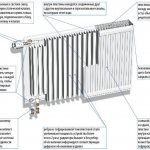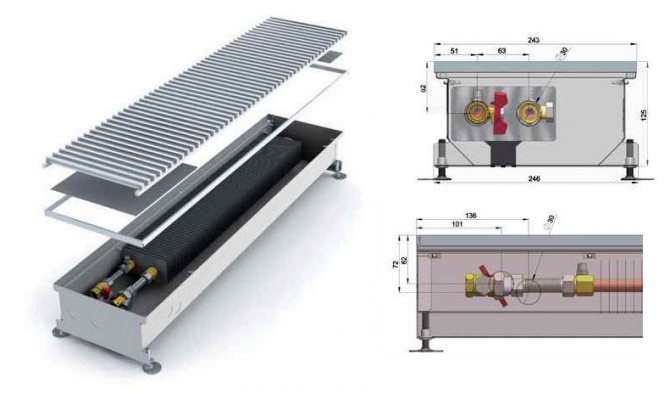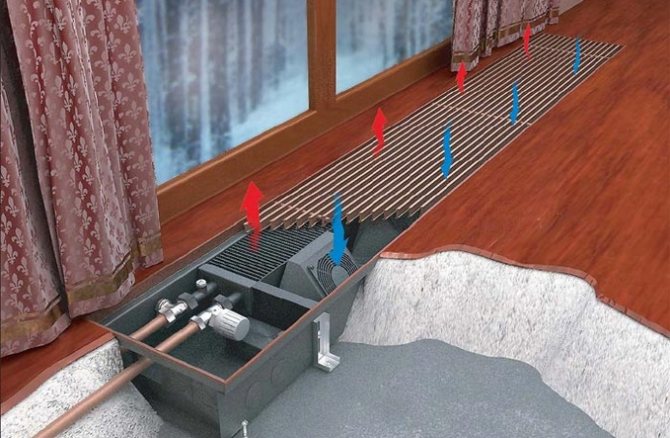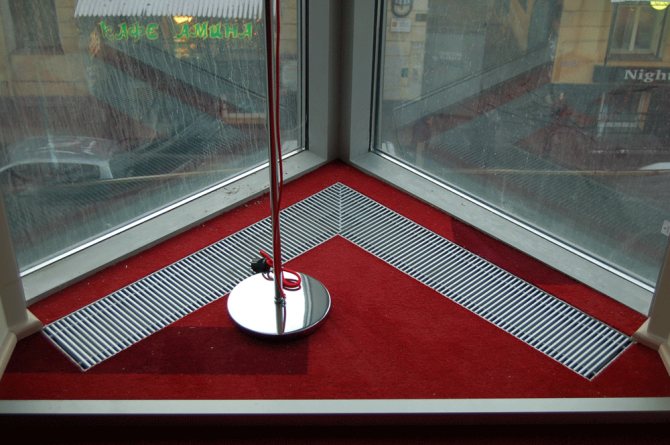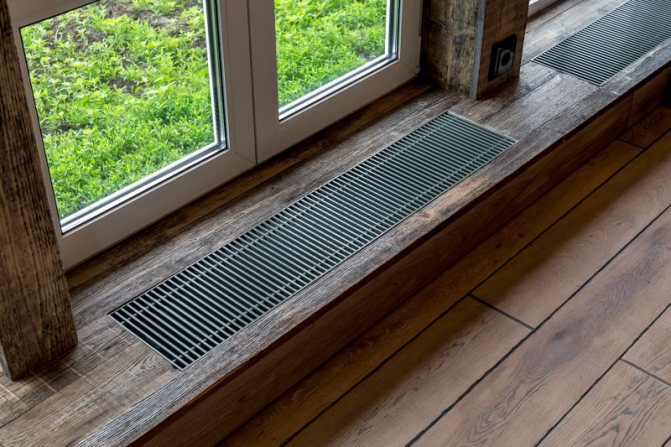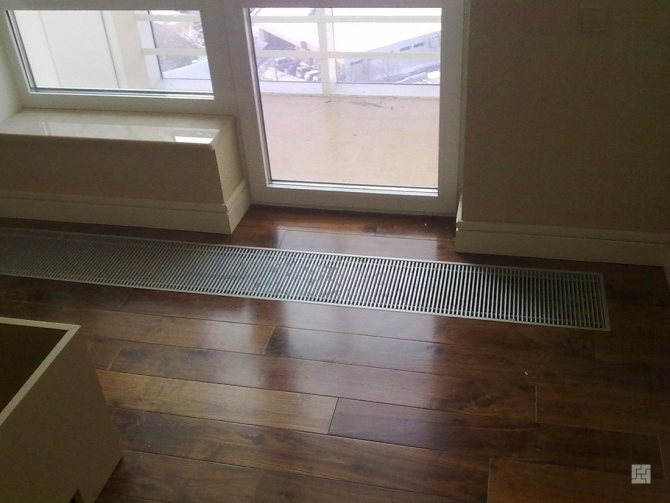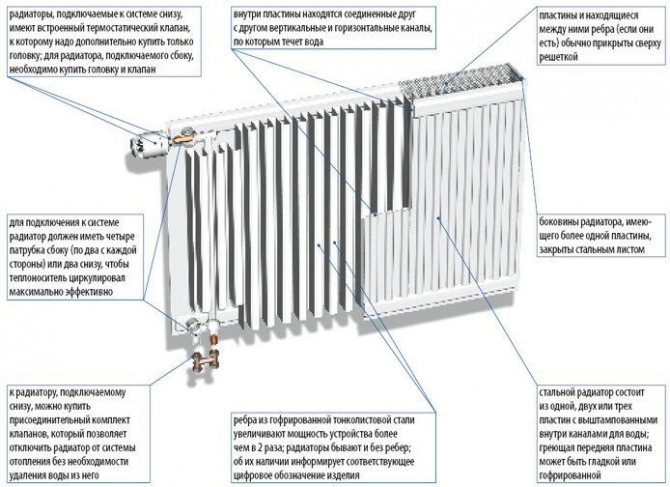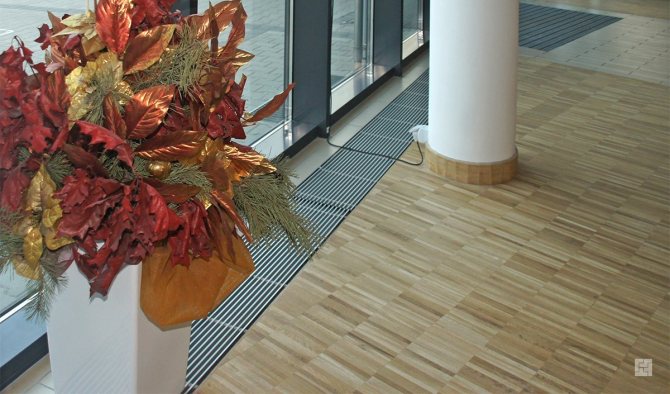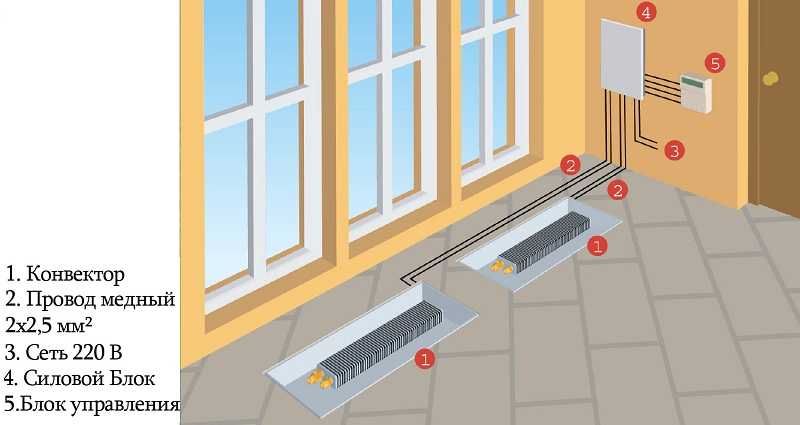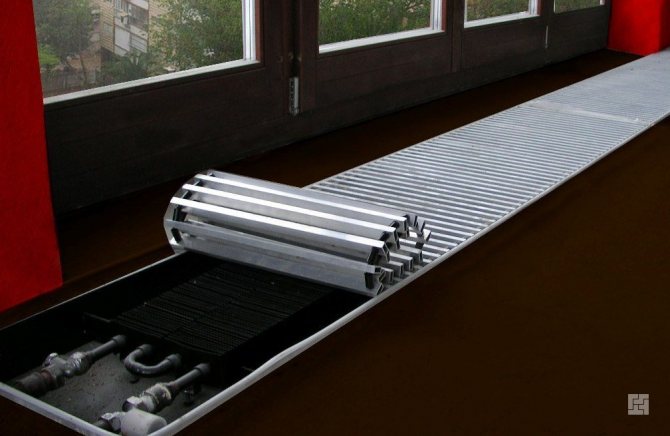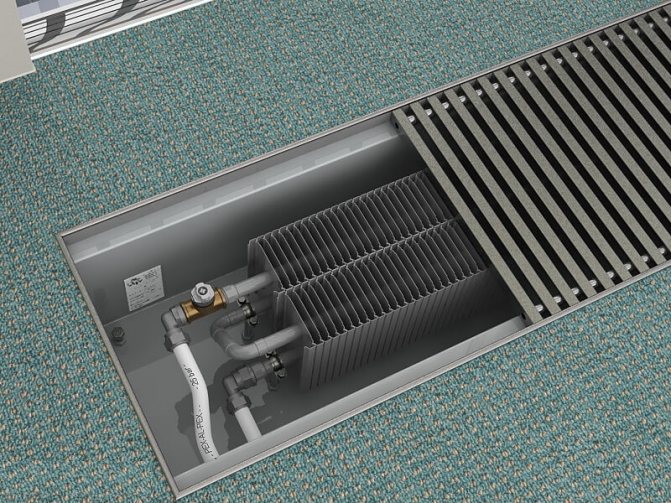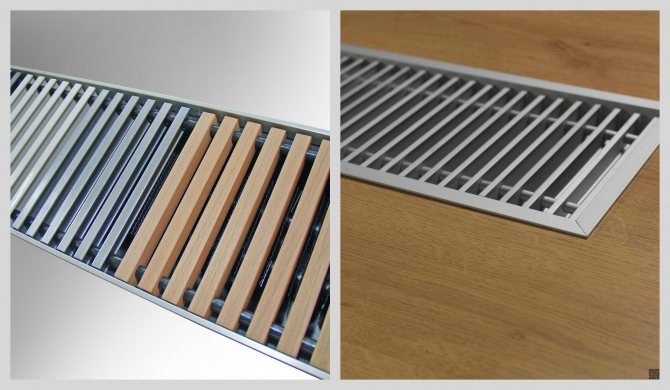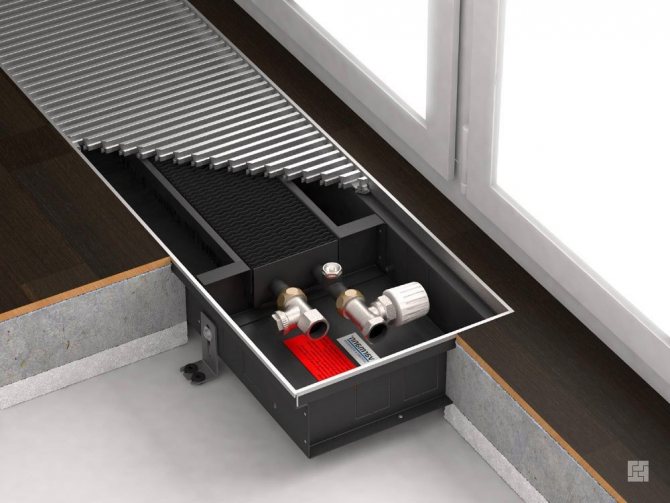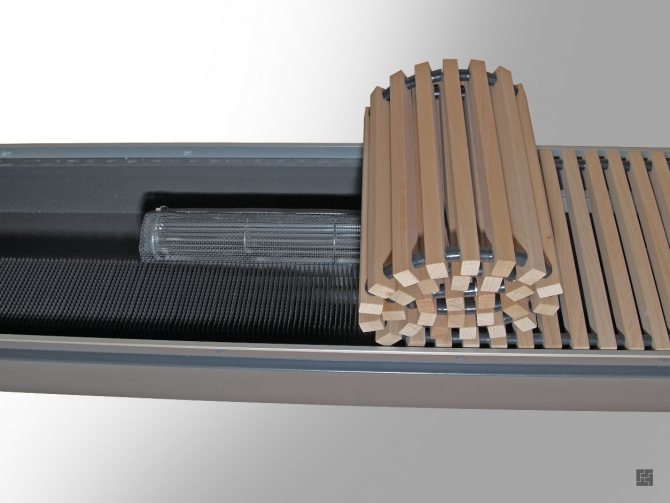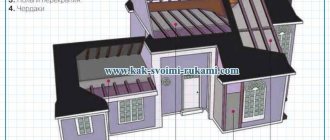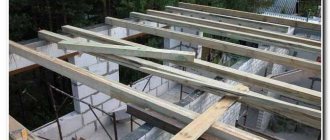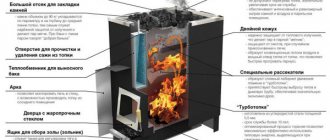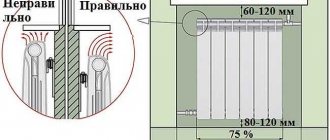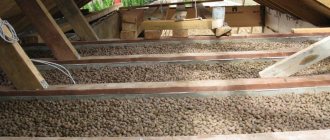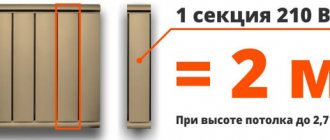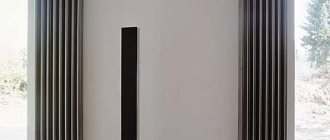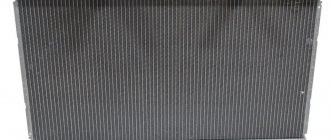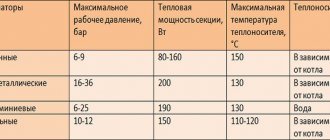Floor heating radiators built into the floor are increasingly used in modern houses and apartments. It is advisable to install such batteries in rooms with panoramic windows, for example, in private buildings, winter gardens, glazed terraces and offices of enterprises. In addition to the main heating function, they help create a thermal curtain that prevents cold air from entering the windows. Before installing a battery for heating in the floor, it is worth evaluating the advantages and disadvantages of such radiators, as well as studying their design features.
Features of these heaters
Batteries that are built into the floor are distinguished by the presence of the following elements:
- heat exchanger. It is a metal tube with a coolant circulating inside it. In electrical devices, heating tubular elements are used. To increase heat transfer, thin copper or aluminum plates are put on the heat exchanger. There is no gap between them and the circuit, which increases the efficiency of the heating system several times. This is possible due to the use of a special technology in the manufacture of such parts;

Battery connection diagram for floor heating - lattice. Close the niche with the heat exchanger. They can be removable or non-removable, depending on the model. The last option is a ready-made block that is installed inside the floor;
- relief valve. This mechanism is designed to remove excess air from the system after filling the heat exchanger with a coolant. It is necessary because the batteries built into the floor are located below everything in relation to other heating elements. Therefore, there is a problem of airing the system, which significantly reduces its efficiency;
- input. It is carried out using the end or side connection.
Advantages and disadvantages
Floor structures have both pros and cons. Having dealt with all these points, you can understand which heating is better to choose for a particular room.
Among the advantages of radiators built into the floor, it is worth noting the following:
- rather long service life, which will allow you not to think about repairing or replacing it after installing the radiator;
- radiators built into the floor have a fairly high performance, but the costs are minimal;
- they are reliable, trouble-free and also environmentally friendly;
- radiators built into the floor are hidden from prying eyes and do not spoil the interior with their appearance. They do not take up space, so they do not interfere with the placement of furniture;
- such models make it possible to install a panoramic window.
With all these advantages, there are points that significantly reduce the popularity of these radiator models.
The disadvantages include the following:
- to install such radiators, it is necessary to increase the height of the ceilings;
- the price of such structures is much higher than that of simple floor or wall models;
- if the ceiling height is more than three meters, then floor-mounted radiators will not work. It is better to purchase wall structures;
- in addition, this type of radiator is much more difficult to install;
- if the radiator has a forced convection function, then the electricity bill will increase significantly. And also such models contribute to the spread of dust.
Models with housing
These underfloor radiators are housed in a galvanized sheet steel casing. To reduce heat loss through metal walls, they are insulated. For the same reason, the battery housing is colored dark.Such radiators are equipped with a heat exchanger with thin metal plates to increase the heat transfer area.
How to choose heating radiators
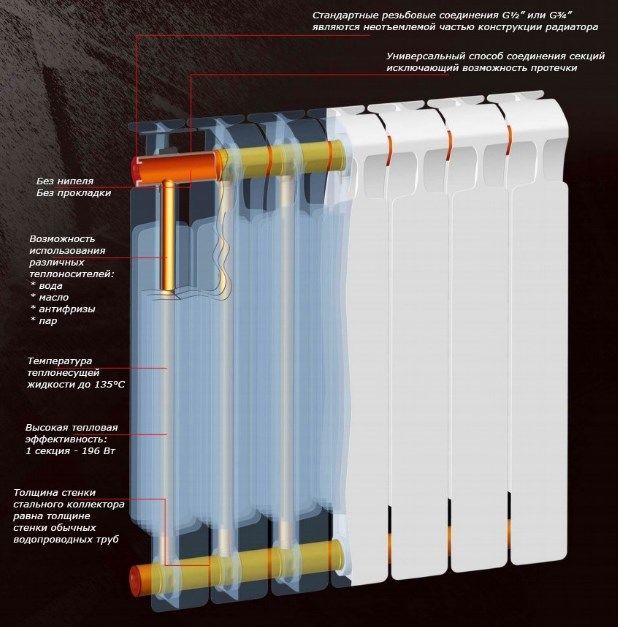

One of the market leaders - Rifar radiator
After installation, these heaters are decorated with grilles. Most often they are made of wood or metal. They are painted in different colors, depending on the chosen design solution.
Floor appliances have a simpler design, but they do not always fit into the interior of the room.
To install these radiators, a channel is made in the floor under a window or in another area of the room. Its dimensions depend on the dimensions of the battery case.
Niche width ranges from 2 to 40 cm, length - from 50 cm to 4 m, depth - from 10 to 80 cm.
Floor radiators that are built into the floor are distinguished depending on the temperature of the coolant:
- high temperature. Characterized by parameters - + 90/70 ° С;
- low temperature. The coolant temperature is + 55/45 ° С.
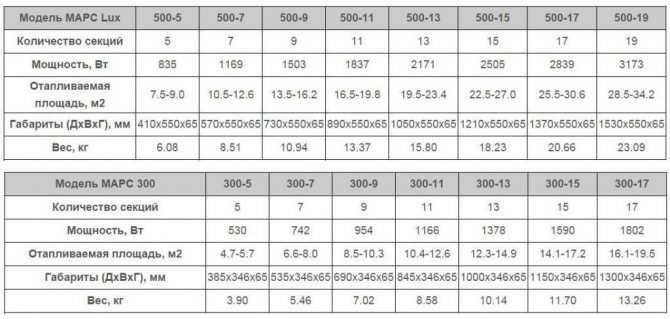

Technical characteristics of copper-aluminum radiators Mars
Weigh the pros and cons
There is no perfect piece of equipment. What are the advantages of floor radiators and what are the restrictions on their use?
5 reasons to choose an underfloor radiator
- Fast and high-quality warming up. A room in which a heating radiator is installed in the floor warms up noticeably faster than rooms equipped with other types of appliances. This is possible thanks to the large heating surface. Fan models heat the air even faster.
- Profitability. To operate the floor radiator, a minimum amount of coolant is required.
- Compactness and lightness. Due to the low weight of the devices, they can be installed in any room. They practically do not create stress on building structures. Floor mounting allows you to solve the problem of finding additional space for the installation of heaters.
- Safety. The low temperature of the decorative grille makes burns impossible. The device itself is as safe as a conventional hot water radiator, does not need "supervision" during operation.
- Affordable price. Radiators are relatively inexpensive, however, there is one "but" - the cost of installation. It is better to entrust it to specialists, which implies additional costs.
A few words about the disadvantages and limitations of the application
As with all convection-type appliances, floor-mounted radiators contribute to the spread of dust. They are installed in rooms where wet cleaning is often carried out. The cleanliness of the grate has to be monitored especially carefully; it is necessary to regularly clean the heating elements as well. In buildings with high ceilings, it is better not to use models with built-in fans, because in this case, warm air will rise above the level of human growth. It is very important to install the equipment correctly so as not to provoke drafts.
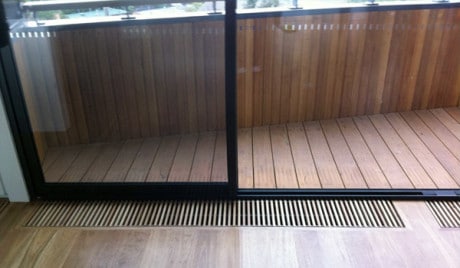

Floor radiators are installed under panoramic windows and large glass doors. They do not block the view and heat the glass
Models without housing
In this case, heating radiators are installed in a specially prepared niche. Its walls are insulated. The most commonly used polyester foam. Batteries of this type are mainly placed in new buildings, where their installation is provided for in the design documentation.
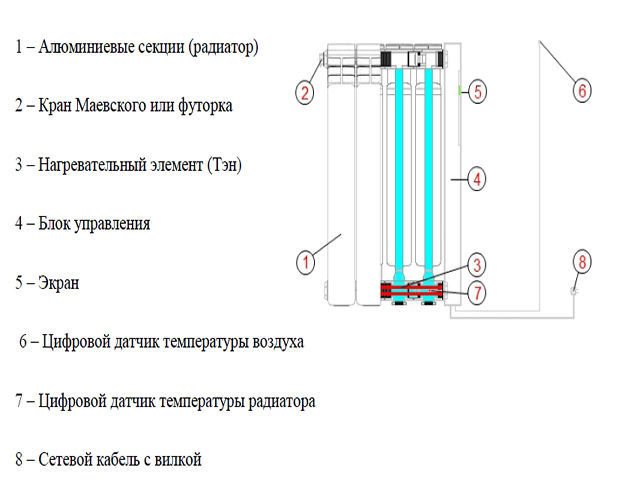

Diagram and principle of operation of a liquid electric radiator
The heating circuit is installed inside the niche at a height of 10 cm from the bottom. This is due to fire safety regulations. Also, the presence of an air gap improves the movement of warm masses and increases the efficiency of the heater.
The channel with heating elements is closed with a special grate.It must withstand the significant load that is possible during operation.
Also, the grille must be removable without fail so that it is possible to clean the channel from accumulated dust. It can be moved away completely or collapsed.
Advantages of floor convectors with recessed flooring
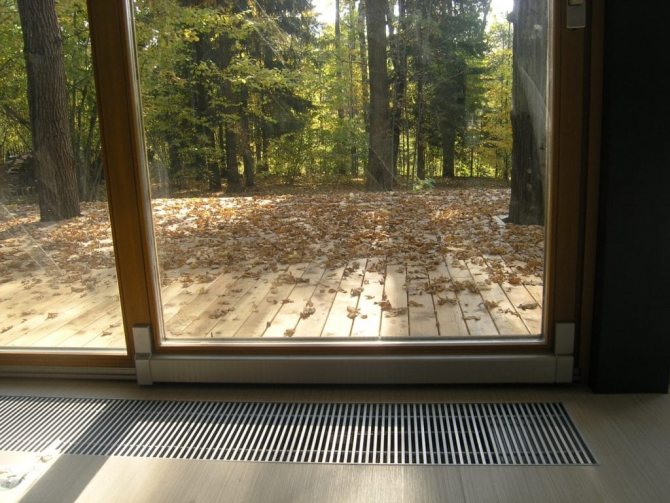

Panoramic glazing and radiator
First of all, all the advantages of this type of heaters are associated with aesthetics and functional features. The most characteristic advantages are in the following criteria:
- High heat dissipation and performance. When using a heat exchange element with water filling, an excellent balance in heat transfer and low financial cost of heating can be achieved;
- Reliability, which consists in trouble-free operation and excellent properties of resistance to aggressive water environments;
- Radiators are installed in floors, which opens up completely unique and interesting architectural possibilities. Batteries of more conservative use were placed on the walls under the window openings. This limited the architecture of the windows, but if the heaters are located in the floors, then all restrictions are removed. You can completely glaze the facade and create panoramic glazing, which is partly used in greenhouses, private houses and rooms with display cases.
Varieties of devices according to the principle of operation
Underfloor heating radiators work in the same way as conventional floor convectors.
Heating the room is possible thanks to air circulation. The heated masses rise to the top of the room. Cold air moves into the device housing, where it heats up. This circulation is provided in several ways:
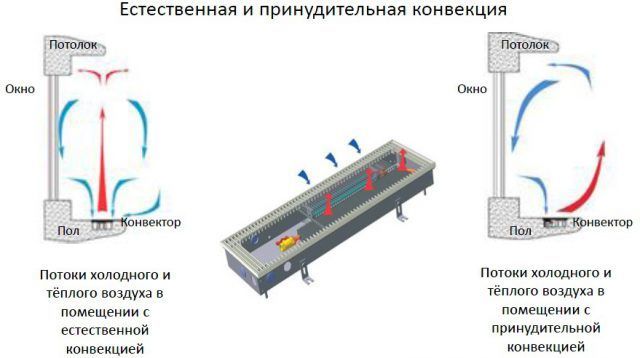

The principle of operation of the floor convector
- natural convention. Air circulation is ensured without additional intervention. Such devices will be effective in rooms with a small area. They are most often used as an additional source of heating, since they do not differ in high power;
- compulsory convention. The system is additionally equipped with a tangential fan, which improves air circulation. Such devices can be used as the main source of heating due to their high power.
Selection recommendations
When buying electric floor radiators for heating, it is imperative to determine what level of power will be needed during operation. And you also need to consider whether it will be a radiator with forced convection or whether a natural function will be enough for a given room.
When buying built-in batteries with heat transfer fluids, it is imperative to take into account several factors.
- Thermal system pressure. This option is suitable for houses with a closed heating system. If you need to install floor-mounted radiators in multi-storey buildings, then you need to immediately look at the pressure level in the pipes. This is done in order to make sure that the set level is sufficient to heat the room. Information on this issue can be obtained from the ZhEK. And only after receiving the necessary information, you can proceed to the selection of a suitable model. Usually, for apartment buildings, a radiator is selected that can withstand fifteen atmospheres.
- The type of coolant and its parameters. For floor-mounted radiators in a private house, any type of coolant is suitable. After all, the owners of their homes themselves control both its temperature and its condition. But for residents of multi-storey buildings, filling radiators is a rather important factor. The wrong choice in this case can create many problems. Therefore, when buying such structures, it is necessary to decide in advance on the model and pay special attention to quality. Attention should be paid to both the Ph level of the liquid and the temperature, and other characteristics of the coolant.
- Connection diameters and type of heating system. The heating system can be one-pipe or two-pipe. Many models of radiators will function normally only when connected to a particular system. Therefore, you should definitely find out all the necessary information when buying from sellers.
If the diameters do not match, you can use adapters.
Floor heating radiators are universal, unlike wall-mounted counterparts. They can be installed in any space, be it residential or office, or commercial. Floor heating radiators are also suitable for private houses with French windows. Such radiators will be appropriate for heating shops, galleries, and even greenhouses. Floor heating radiators are used with great success for rooms with a special microclimate.
When buying such radiators, you should pay attention to models that have a condensate drain function, which is characterized by convenience in everyday life. All actions of such devices are regulated by an automatic system, which allows you to preset the required temperature mode.
Additional elements of the underfloor heating system
To increase efficiency and convenience during operation, heating devices of this type are equipped with additional elements:
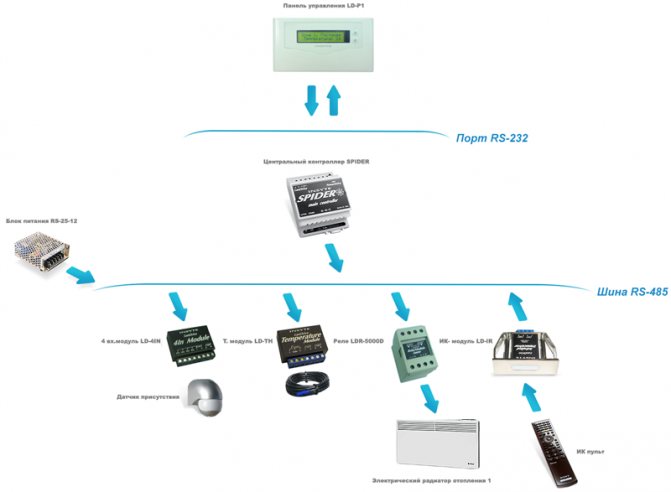

Control kit for 2 or more electric heating radiators
- thermostats. Allow in automatic mode to set the required operating mode of the heating elements;
- coolant drain system. Provides the use of the device as an air conditioner for air cooling;
- remote control panel. The element is designed for remote control over the operating parameters of the system from anywhere in the house.
Heating system installation
Batteries of this type are most often installed under a window in a specially prepared niche. To do this, a hole is made in the screed, which will be 1-3 cm larger than the dimensions of the device case on each side. The equipment is installed in a horizontal position. Adjustment is made with four bolts (included) and a building level.


The most common radiator connection diagrams
To fix the bottom and side walls, before pouring the heat-insulating substance, temporarily spacers are installed, which are removed after the polyurethane foam has set. The heating elements are fixed in position using a freshly prepared solution.
After installing the radiator, it is covered with a special grille and started to operate. To do this, during the installation of the device, you need not to hammer in connecting it to the mains or water heating - depending on the model used.
Scope of floor heating radiators
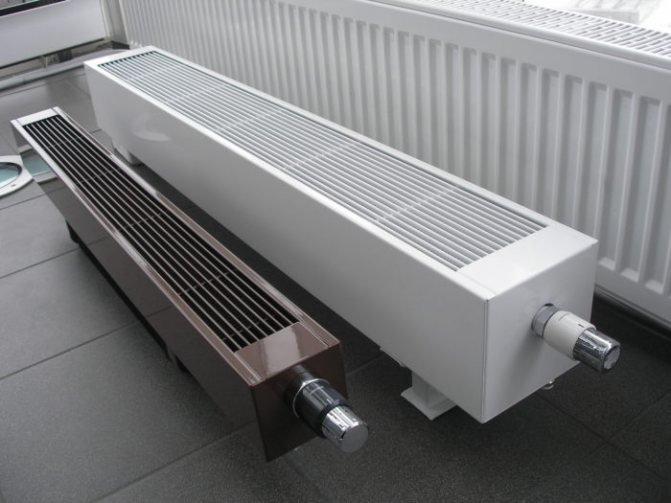

Water floor heating batteries are used in the following cases:
- If it is not possible to install traditional high mounted batteries. Such situations arise if the walls in the house are made of fragile loose materials, therefore it is forbidden to hang even aluminum appliances on them.
- Low floor heating radiators for panoramic windows are installed in shop windows and shopping centers. A heat source must be installed near panoramic windows to prevent freezing and fogging.
The main difference between these devices and traditional batteries is that they are not mounted on the walls of the room, but installed on the floor and attached to it. These radiators are compact in size and are not as tall as hinged batteries.
Advantages and disadvantages
Floor-standing low heating radiators have the following advantages:
- the device can be installed in any part of the room, regardless of the size of the window openings;
- ergonomics and saving free space in the room;
- the unit has a modern appearance and fits into any interior style;
- allow you to create a thermal curtain in front of the windows to the floor, where a hinged radiator cannot be installed;
- suitable for use in houses with walls made of fragile, loose materials, on which traditional appliances cannot be hung.
Among the disadvantages of floor heating batteries are the following:
- Certain difficulties arise with the inconspicuous laying of pipes. So that they do not interfere, they are laid in the floor screed. This is bad from the point of view of repair and maintenance of heating networks.
- Such radiators are not suitable for heating large rooms, because the heat is unevenly distributed in them. Some parts of the room may not be heated at all.
- Hidden laying of pipelines creates certain difficulties when installing radiators, because you need to equip a floor screed of a certain height.
Important! The main disadvantage of floor-standing batteries is that they are more expensive than traditional units, but at the same time they heat high rooms worse.
Types of outdoor batteries by design and material
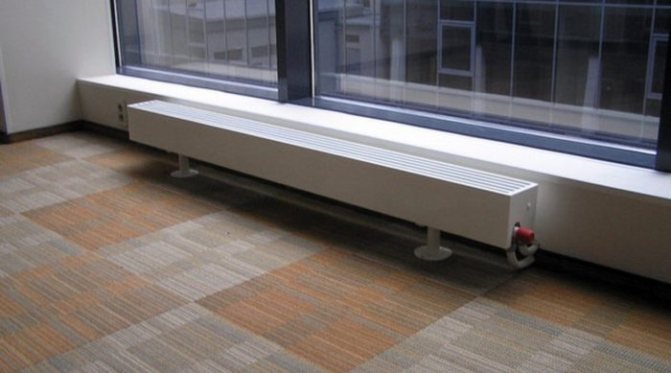

Floor-standing horizontal heating radiators are divided into several types depending on the material of execution:
- Cast iron appliances have been actively used in the last century. They cannot boast of attractiveness. The main disadvantage of these devices is that they quickly silt up, so they need to be flushed every 2-3 years. Such radiators can crack during water hammer and significant mechanical stress.
- Batteries have become more common. They are durable and beautiful. The most vulnerable to leaks are steel plate radiators, because they often leak along the weld.
- Bimetallic devices have a steel core and an aluminum body. They are visually attractive, durable and have high heat dissipation. Thanks to the aluminum housing, heat dissipation is increased, and the steel core protects the aluminum parts from contact with the coolant and corrosion.
- Aluminum radiators are appreciated for their lightness, but they are not suitable for centralized systems of multi-storey buildings, because they cannot withstand increased pressure in the main line and do not tolerate water hammer. Aluminum forms galvanic vapors with some types of metals, therefore, copper pipes and fittings are prohibited in such circuits.
By design, such batteries are divided into sectional and panel ones. The first type is made from aluminum, cast iron and bimetal, and panel devices are only steel. In addition, all floor standing radiators differ in height. The higher the battery, the less heat loss with a small number of sections.

